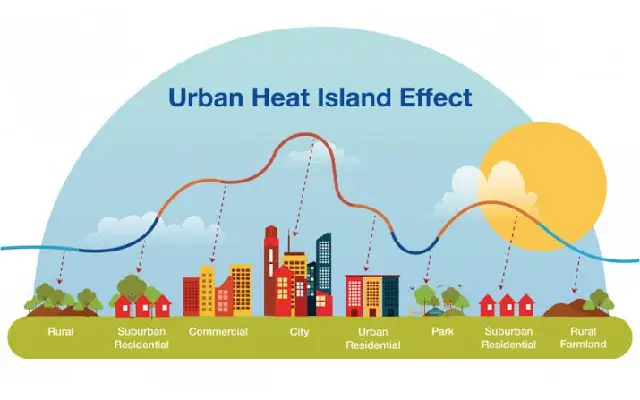Bengaluru residents faced an unprecedented heatwave on March 29, with temperatures soaring to 36.4 degrees Celsius, marking the hottest March day in the last five years. This surge in temperature, attributed to various factors including human activities and urbanization, underscores the urgent need for comprehensive strategies to mitigate the effects of urban heat islands.
Impact of Urban Development on Temperature Rise: Urbanization and construction activities significantly contribute to environmental changes, with materials used in construction amplifying the urban heat island effect. Concrete, commonly used in construction, absorbs and reflects heat, leading to elevated air temperatures. Furthermore, increased energy consumption, particularly from air conditioning, exacerbates the issue by releasing heat into the urban environment.
Critical Analysis by Experts: Experts such as Dr. Monto Mani from the Indian Institute of Science highlight the role of excessive building heat sinks and the thermal storage effect in urban areas. The proliferation of concrete cover and vehicular emissions further intensifies the urban heat island phenomenon, necessitating urgent intervention.
Challenges in Urban Planning: Mallanna Sasalu, a housing company head, emphasizes the importance of urban planning in mitigating heat island effects. He criticizes the lack of foresight in city planning, advocating for a balance between development and environmental preservation. Sasalu calls for stricter regulations to protect green spaces and water bodies, essential for cooling the city.
Policy Recommendations: Architect Yashaswini Sharma and Dr. Monto Mani propose policy interventions to combat urban heat islands. Sharma suggests incentivizing sustainable construction practices and mandating rainwater harvesting. Dr. Mani emphasizes the need for energy-efficient buildings and renewable energy adoption to reduce urban heat generation.
Practical Solutions for Built-Up Spaces: Experts recommend practical solutions for existing built-up areas, including the creation of green spaces, installation of photovoltaic cells for energy generation, and promoting passive cooling techniques. Additionally, measures such as capping water and electricity usage per person can encourage energy conservation.
Climate Action Plan for Bengaluru: The Climate Action Plan for Bengaluru advocates for reducing the impact of heat islands through energy-efficient building materials and retrofitting existing structures. It emphasizes the importance of green roofs, rainwater harvesting systems, and transitioning to renewable energy sources.
Conclusion: Addressing urban heat islands in Bengaluru requires a multi-faceted approach involving urban planning, policy interventions, and community participation. By implementing sustainable construction practices, promoting green infrastructure, and transitioning to renewable energy, Bengaluru can mitigate the adverse effects of rising temperatures and build a resilient and sustainable urban environment for future generations.

















